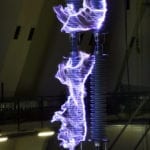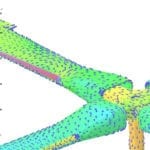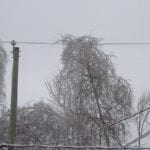
Maybe you know this story: There’s a thunderstorm. Lightning strikes nearby. The power cuts out for a moment, then returns. But when you try to switch on the TV, it doesn’t seem to work.
Each year, hundreds and thousands of homes and their electrical systems and equipment are damaged by voltage spikes and surges.
How does a power surge or spike cause damage?
In the United States, most homes use 120 volt electrical power with 60 hertz, single phase, alternating current (AC).
By design, AC voltage is not delivered at a constant 120 volts. Instead, the voltage rises and falls in a predetermined rhythm (i.e. 60 hertz) where the voltage oscillates from 0 to a peak voltage of 169 volts.
During a power surge (or spike), the voltage exceeds this peak voltage. Increasing voltage above an appliance’s normal operating voltage can cause an arc of electrical current within the appliance, and the heat generated in the arc can cause damage to the electronic circuit boards and other electrical components.
Both types can slowly cause damage your electronic equipment over time, eventually shortening the life span of appliances and electronics.
Source of Electrical Spikes and Surges
Although direct lightning strikes have the most destructive power, there are many other sources:
- Direct Lightning Strikes
- Indirect Lighting Strikes
- Utility Work
- Trees and other obstructions
- House Appliances
- Cable and Phone Company Utility Lines
Direct Lightning Strikes
 A typical lightning strike peaks around 100,000 Amps where all of the lightning’s energy is directed through the body or over the body on the skin.
A typical lightning strike peaks around 100,000 Amps where all of the lightning’s energy is directed through the body or over the body on the skin.
Even a dedicated lightning protection system cannot handle 100% of the current generated by a direct lightning strike.
That means if just 0.1% of the current is leaked to the house wiring system, 100 amps will surge through wires, resulting in electronic equipment damage.
To achieve 100% effectiveness, all electronic equipment must be disconnected from the house wiring. With 15+ appliances, small appliances and various electronic equipment, that is no easy task either.
back to top
Indirect Lightning Strikes
 Unless you happen to live in Florida, the lightning capital of the world, indirect lightning strikes are more common.
Unless you happen to live in Florida, the lightning capital of the world, indirect lightning strikes are more common.
Because a lightning’s magnetic force is very powerful, it can travel long distances through a ground current, often building up charges along the way on a buried cable’s metal shield, until it zaps an unprotected electronic equipment.
The second method of travel is through a “side flash”. Because electricity always finds a path of least resistance, side flash happens when lightning strikes an object and jumps through the air to a second object that has less resistance
back to top
Power Electric Utility Work
 Overvoltages are also caused by electric utility companies (POCO, power compnay) working on their equipment like repairing or replacing transformers, tapping new lines, etc.
Overvoltages are also caused by electric utility companies (POCO, power compnay) working on their equipment like repairing or replacing transformers, tapping new lines, etc.
All these activities may cause surges on utility lines as periodic spikes, surges and brownouts which can cause expensive damages to unprotected electronic components (you can read my blog posts are appliance repairs here).
Trees and other Obstructions
 Trees falling or coming into contact with power lines is by far the most common cause of power outages in a residential setting.
Trees falling or coming into contact with power lines is by far the most common cause of power outages in a residential setting.
When trees touch, or come close to touching, an overhead electric wire, several things can happen:
- children climbing that tree can get shocked or killed;
- the branch can break from the weight of snow and ice in winter and fall on the wire causing a power outage;
- winds can whip limbs into the line and break one or both;
- branch can merely brush against an energized wire and catch on fire
House Appliances
 Any appliances with large current demand (i.e. washer, refrigerator, microwave, etc.) can place sudden electricity demand on the house wiring and as a result, produce spikes and surges that will cause problems for other equipment.
Any appliances with large current demand (i.e. washer, refrigerator, microwave, etc.) can place sudden electricity demand on the house wiring and as a result, produce spikes and surges that will cause problems for other equipment.
For example, both a washing machine (with a massive motor solenoid) and a refrigerator (with a high-draw compressor motor) that shunts on and off frequently can cause a great deal of pulse fluctuations throughout the house wiring, resulting in electronic component degradation over a period of time.
Cable and Phone Company Utility lines
 Lastly, we shouldn’t forget about a phone line, cable (coaxial) lines, roof mounted antennas and satellite dishes.
Lastly, we shouldn’t forget about a phone line, cable (coaxial) lines, roof mounted antennas and satellite dishes.
Some or all of these lines provide a conductive pathway for power surges and spikes to enter our homes and cause damage.
For example, if your cable connects directly to your setop box unprotected, a surge can travel through it and all other connected devices and do damage, even if those other devices are protected.
Grounding or earthing your cable system may provide some protection against voltage surges and built-up static charges but all outside connections need to go through a protective device to reduce the risk of electric spikes and surges.
Conclusion
Electrical surges can instantly overload and short out the circuitry of home electronics and anything else plugged into the wall, or they can degrade them over time.
Learning more about surges can help save money and how to protect your property.
Read more about how you can protect your valuable electronic equipment here.
BTW, if you found this article to be helpful, can you do me a favor and sign up for my free newsletter? The form is located on the upper right side of the screen.
Thank you!


Brian
Tuesday 25th of January 2022
Hello Kevin: Interesting article with good practical advice. I live in the Northeast where we get a lot of snow and the trees grow very quickly, coming into contact with the power lines. I have a long, steep driveway and use a large 12hp snowblower. If I contact energized trees with the snowblower can I get a dangerous electrical shock? I have sent pictures to the power company but have not received a reply. Thanks in advance, Brian